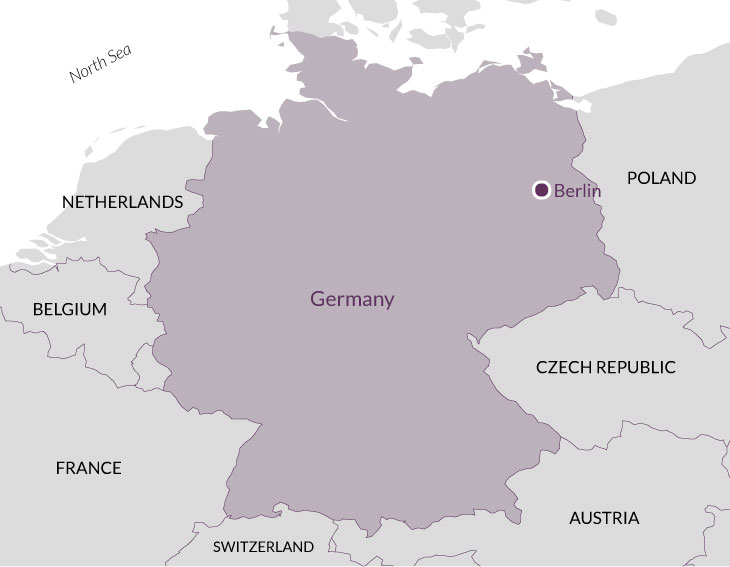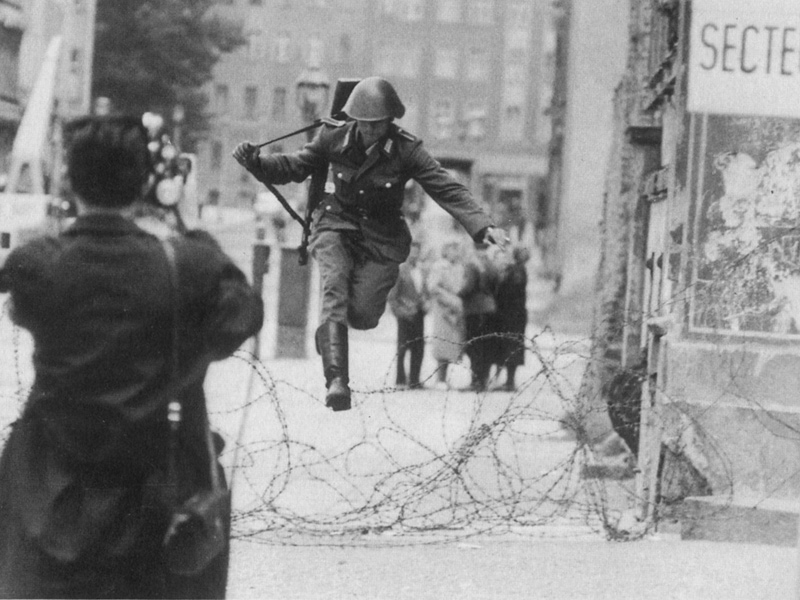Overview
For nearly forty years after World War Two the world lived with the incessant anxiety of annihilation through the doctrine of ‘Mutually Assured Destruction’. There seemed little likelihood of compromise and none of conciliation between the two great geopolitical blocs, and many of the wars around the globe were superpower conflicts by proxy. But there was nothing vicarious about the confrontation in Berlin. Here military personnel on both sides looked each other in the eye from a few feet away. Here, it was widely believed, the Third World War was most likely to begin.
Though only a few traces remain, the Wall is the most striking memorial of that bizarre and frightening era. Staggering in its brazenness and cruelty, it was erected in 1961 as the culmination of attempts by the eastern sector to stop its citizens fleeing to the West, and was continually refined until its sudden breach in 1989.
That is but one thread in an extraordinary and multi-faceted story which began in Year Zero, 1945. Concentrated bombardments had reduced Berlin to ruins with most of the houses flattened or uninhabitable (it took 12 years to clear the rubble), thousands starved to death each day, there was an almost complete breakdown of law and order and rape by Soviet soldiery was on a horrific scale.
Cold War Berlin is also a story of global politics, of visits by Kennedy, Khrushchev, Gorbachev and Reagan, of appeasement and resistance, of the 462-day Blockade (1948–9) and of how a devastated and deeply unstable city became a heroic beacon of western values. There is also the story of the manipulation of democratic processes to impose a tyrannical regime in the Soviet sector; a proper historical analysis overturns the currently fashionable nostalgia for the DDR.
Berlin was also of course the spy capital of the world, the peculiarities of its administration allowing for clandestine meetings and exchanges of information. This is the world of John Le Carré and Len Deighton, though fiction should not be taken as fact. Some of what went on is still officially secret.
Day 1
Fly from London Heathrow at c. 10.45am to Berlin Tegel (British Airways). Drive around the city to Karl-Marx Allee (Stalinallee until 1956), a showpiece boulevard of socialist monumentalism. The Berlin Wall Memorial on Bernauer Strasse retains one of the few complete sections with double wall and death strip. Alexanderplatz and the Marx-Engels Forum are open spaces at the heart of the Soviet sector, dominated by the Television Tower.
Day 2
Berlin, Kunersdorf. Drive east of Berlin to the Cold War Museum, whose permanent exhibition is housed close to a nuclear bunker. In the afternoon drive to Treptow to visit the Soviet War Memorial where 300,000 are buried, a salutary reminder of another side of the story. Some free time for the DDR Museum or one of the great art museums.
Day 3
Berlin. Visit the Gedenkstätte Hohenschönhausen, a Soviet then Stasi (secret police) prison for political deviants, and the Stasi HQ at Normannenstrasse, largely left as it was in 1990 and revealing the extraordinary scale of surveillance of DDR citizens. Checkpoint Charlie was the infamous crossing point between American and Soviet sectors (marked by a replica hut and museum), and Zimmerstrasse was the site of the Fechter shooting which shocked the world.
Day 4
Berlin, Potsdam. Drive to Potsdam and visit Cecilienhof, the English-style mansion built for the Crown Prince in 1913 and scene in 1945 of the Potsdam Conference (where Atlee replaced Churchill midway). Then there is a special walk along the site of the Wall to the Glienicke Bridge on the south-western edge of Berlin. Straddling the border, it was used for the exchange of prisoners. The Allied Museum in Zehlendorf well illustrates the western occupation.
Day 5
Berlin. Recently restored, Schloss Schönhausen contains the residence of Wilhelm Pieck, President of the DDR. Pariser Platz and around: the Brandenburg Gate, the most potent symbol of tragedy and triumph, the Russian (formerly Soviet) embassy, the Soviet War Memorial in the British sector. At the Reichstag the Cold War symbolically came to an end with the reunification ceremony in 1990. Lunch is here in the restaurant under its great glass dome. On the way to the airport stop at Schöneberg Town Hall, seat of Berlin city government of the western sectors and site of Kennedy’s speech: ‘Ich bin ein Berliner’. Return to Heathrow c. 5.45pm.
Price
£1,770. This includes: flights (Euro Traveller) with British Airways (aircraft: Airbus A319); travel by private coach; accommodation as described below; breakfasts, 2 lunches & 3 dinners with wine; all admission charges; all tips; all taxes; the services of the lecturer and tour manager. Single supplement £190 (double room for single occupancy). Price without flights £1,590.
Accommodation
The Westin Grand Berlin: a stylish but traditional hotel close to Unter den Linden.
How strenuous?
Quite a lot of walking is required and standing around is unavoidable. Average distance by coach per day: 32 miles (primarily on two days of the tour.)
Are you fit enough to join the tour?
Group size
Between 10 and 22 participants.
Travel advice
Before booking, please refer to the FCDO website to ensure you are happy with the travel advice for the destination(s) you are visiting.

'The lecturer's first-hand military experience gave us a unique insight into life in Berlin during the 1980s. I found his evening lectures both fascinating and stimulating.'
'Very knowledgeable lecturer - often based on his direct experience as an army officer. Went out of his way to provoke discussion and test our knowledge.'
'A very enjoyable trip. Small number of people and fascinating subject matter in one of the world’s most interesting cities.'
